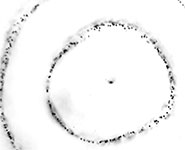The researchers have shown experimentally how tiny particles, such as cells, or any small objects can be trapped by a spinning ultrasonic, or sonic, vortex. The vortex acts as a lasso that can be controlled and moved, catching the microscopic particles and enabling their careful positioning.
This new technology makes possible applications such as assembly human tissue from a collection of cells and assembling nano materials.
Bruce Drinkwater, Professor of Ultrasonics in the Department of Mechanical Engineering and who led the study, said: “Our research has shown we can grip and move particles pretty much anywhere and along any path. The impressive thing is that it is completely non-contact, harmless and so ideal for moving delicate things, such as cells, around under a microscope. With further development this could be used to assemble human tissue as part of a tissue engineering production line.”
The paper explains that acoustic vortices, known as Bessel-functions, can be used to trap and controllably position microparticles. Like a rope lasso, the waves carry linear and rotational momentum and so can cause the objects to spin as well as move. A circular device, made up of 16 ultrasound sources, generates and manipulates an acoustic field within a chamber, trapping microparticles and clusters of microparticles. Changes in the phase of the sinusoidal signals applied to the sources result in the movement of the Bessel-function pressure field and therefore the microparticles.
This research has been funded by the Engineering and Physical Sciences Research Council (EPSRC) through the Electronic Sonotweezers programme.
Paper: Dexterous manipulation of microparticles using Bessel-function acoustic pressure fields, Charles Courtney (Bristol), Bruce Drinkwater (Bristol), Christine Demore (Dundee), Sandy Cochran (Dundee), Alon Grinenko (Bristol), Paul Wilcox (Bristol), Applied Physics Letters, published online April 2013.
